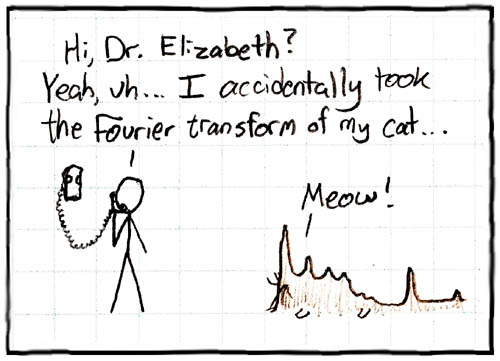We at CatSynth never miss an opportunity to combine mathematics and cats. Recently, our friends at Walking Randomly posted this image:

It was created by Andrew J. Bennieston, and inspired by this comic from xkcd:

Unlike the number theory and other mathematics we like to post here at CatSynth, the Fourier Transform is part of our stock and trade. There are many variants, including the Discrete Time Fourier Transform which one of the basic tools of signal processing and sound synthesis:

Basically, what a Fourier Transform does is decompose a signal (or any time-varying mathematical function) into separate frequencies. If you have a spectrum representation of a sound, this is output of a Fourier Transform. Similarly, if you have a graphic equalizer on your stereo, it can be seen as operating on a very low-resolution Fourier transform, as it allows one to raise and lower different frequency ranges of sound.
For images, “frequency” corresponds to detail. Highly detailed areas of image that change from pixel to pixel are high-frequency, while areas of constant color or intensity are lower frequency. Another variant of the Fourier Transform, the Discrete Cosine Transform, or DCT, is more often used with images because it tends to put more information in lower frequencies.
Theoritcally, one should not lose any information when taking a Fourier Transform of a signal (or image) and taking the inverse to retrieve the original. However, in Bennieston’s image, which applies two DCTs to the original image, results in the “ghost” that loses a bit of the original detail. Certainly, some is due to the rounding error when doing any calculations on the computer, but it seems like more than that. Most, likely, the DCT is more sensitive the boundaries, i.e., what happens at the beginning or end of a signal.
DCTs are often used in “lossy” image and audio compression, such as JPEG for images. However, I have rarely seen them used in music applications, where one tends to see more general Fourier Transformations, which correspond more closely to an intuitive understanding of musical frequency.
As such, it would be interesting to work with DCTs in a musical context and see what transpires. If we ever get around to this project, we will certainly post it here on CatSynth.
This post is part of the Carnival of Mathematics which is being hosted this weekend by Logic Nest.



